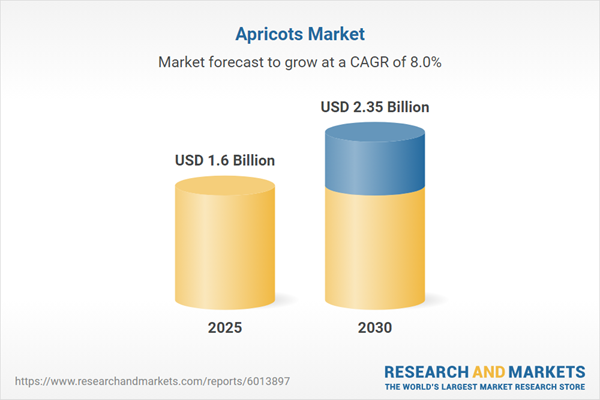Speak directly to the analyst to clarify any post sales queries you may have.
Positioned for multi-sector relevance, the apricots market demonstrates robust expansion driven by evolving consumer preferences, sustainability imperatives, and advances in technology. This report equips senior decision-makers with actionable insight into the complex forces shaping strategic growth and risk mitigation across the global apricot supply chain.
Market Snapshot: Apricots Market Size and Growth Overview
The apricots market grew from USD 1.48 billion in 2024 to USD 1.60 billion in 2025. Looking ahead, it is projected to maintain an 8.22% CAGR, reaching USD 2.79 billion by 2032. This strong performance reflects increasing demand from health-conscious consumers, innovative product development across food, cosmetic, and nutraceutical applications, and greater focus on supply chain efficiency in response to policy shifts and sustainability expectations.
Scope & Segmentation: Apricots Market Coverage
Comprehensive in scope, this analysis explores the apricots market through multiple lenses:
- Product Types: Dried apricots (sliced, whole), fresh apricots, processed apricots (jam, juice, puree).
- End Uses: Food and beverage applications (bakery, confectionery, desserts, snacks), cosmetics (hair care, skin care), pharmaceuticals (dietary supplements).
- Distribution Channels: Convenience stores, online retail (company websites, third-party platforms), specialty stores, supermarkets, hypermarkets.
- Packaging Types: Bulk, cans, jars (glass, plastic), pouches (stand-up, vacuum).
- Geographies: Americas (North America: United States, Canada, Mexico; Latin America: Brazil, Argentina, Chile, Colombia, Peru), Europe, Middle East & Africa (Europe: United Kingdom, Germany, France, Russia, Italy, Spain, Netherlands, Sweden, Poland, Switzerland; Middle East: UAE, Saudi Arabia, Qatar, Turkey, Israel; Africa: South Africa, Nigeria, Egypt, Kenya), Asia-Pacific (China, India, Japan, Australia, South Korea, Indonesia, Thailand, Malaysia, Singapore, Taiwan).
- Key Companies: Sunsweet Growers, Inc., Universal Foods Corporation, Oasis Fruit International Ltd., Mariani Packing Co., Inc., Milne Fruit Products, Inc., Sahut-Conserves, Mediterranean Fruits Company SA, Taris Zeytin ve Zeytinyağı Tarımsal Kalkınma Kooperatifleri Birliği, Kayalar Gıda Sanayi ve Ticaret A.Ş., Orleysa S.A.
Key Takeaways for Decision-Makers
- Consumer shift toward clean-label, plant-based, and functional snacks elevates apricot demand and expands opportunities for both fresh and value-added formats.
- Technological advancements, like precision agriculture and advanced packaging, support consistent quality and sustainability efforts throughout the supply chain.
- Brands leveraging digital platforms and traceability can strengthen consumer trust and unlock direct-to-consumer revenue streams in established and emerging markets.
- Apricots are increasingly integrated into non-food verticals, with growing utilization in cosmetics and nutraceuticals reflecting their functional ingredient status.
- Strategic partnerships across agriculture, processing, and distribution enable companies to respond flexibly to supply disruptions and diversify product portfolios.
- Regional differences in production, consumer taste, and distribution channels call for tailored go-to-market strategies to maximize commercial potential.
Tariff Impact: Navigating Policy Shifts
Recent U.S. tariff adjustments affecting imported apricot products have altered total landed costs, pressuring importers and retailers to reconsider sourcing and pricing models. Domestic producers and processors have responded by scaling capacity and investing in automation, while smaller enterprises seek alternative origins and higher-margin products to offset cost volatility. Agile supply chain reconfiguration is proving essential for sustaining profitability amid policy-driven disruptions.
Methodology & Data Sources
This research is grounded in integrated qualitative and quantitative methodologies. Primary interviews with growers, processors, and retail category managers complemented secondary reviews of academic literature, government data, and market intelligence platforms. Triangulation and validation of all sources ensure a reliable and holistic understanding of apricot sector trends.
Why This Report Matters
- Empowers senior leaders with evidence-based strategies to bolster supply chain resilience and capitalize on market diversification.
- Details actionable scenarios for leveraging innovation and sustainability to drive long-term brand equity and operational efficiency.
- Enables informed decision-making amid regulatory shifts, shifting consumer demand, and intensifying competitive activity across global territories.
Conclusion
The apricots market is evolving through technological progress, sustainability focus, and changing regulation. Leaders who invest in agile systems and data-driven insight can unlock new growth and build future-ready strategies amid ongoing transformation.
Additional Product Information:
- Purchase of this report includes 1 year online access with quarterly updates.
- This report can be updated on request. Please contact our Customer Experience team using the Ask a Question widget on our website.
Table of Contents
3. Executive Summary
4. Market Overview
7. Cumulative Impact of Artificial Intelligence 2025
Companies Mentioned
The companies profiled in this Apricots market report include:- Sunsweet Growers, Inc.
- Universal Foods Corporation
- Oasis Fruit International Ltd.
- Mariani Packing Co., Inc.
- Milne Fruit Products, Inc.
- Sahut-Conserves
- Mediterranean Fruits Company SA
- Taris Zeytin ve Zeytinyağı Tarımsal Kalkınma Kooperatifleri Birliği
- Kayalar Gıda Sanayi ve Ticaret A.Ş.
- Orleysa S.A.
Table Information
| Report Attribute | Details |
|---|---|
| No. of Pages | 184 |
| Published | October 2025 |
| Forecast Period | 2025 - 2032 |
| Estimated Market Value ( USD | $ 1.6 Billion |
| Forecasted Market Value ( USD | $ 2.79 Billion |
| Compound Annual Growth Rate | 8.2% |
| Regions Covered | Global |
| No. of Companies Mentioned | 11 |









